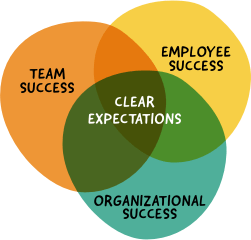Report
A performance culture to serve all government employees

Revisiting performance in a hybrid work world
Revisiting what sustains and enhances performance—and ensuring that the workforce understands performance expectations—is essential. Yet research from Eagle Hill Consulting reveals that 36% of hybrid government employees find it challenging to get constructive feedback from team leaders and managers.
Managing performance in government has changed but it is more important than ever
In this hybrid work environment, the metrics and competencies that managers and employees are accountable for haven’t changed. But the ways to manage and perform against them have changed. And in many cases, government employees are left in the dark as to how their performance is being measured.
This change comes largely from the fact that managers, teams, and employees don’t have as much in-person time anymore. When people aren’t with each other every day, they can’t share immediate feedback, check in on workstreams, stop by a colleague’s desk for a quick chat, or collaborate spontaneously. Plus, managing hybrid and virtual employees requires a level of trust that some leaders are not accustomed to (or comfortable with), particularly those who manage by inputs rather than outcomes.
There are clear advantages to managing by outcomes. Consider that 75% of government employees feel more committed to quality outcomes over the past two years since the pandemic began. But there appears to be an understanding gap for government employees in how quality outcomes relate to performance. Our research reveals that 83% of employees want to know more about how performance is measured. Closing this understanding gap can help agencies stand out in a competitive labor market—and help improve organizational performance.
Same performance expectations, new worries
Leaders
“Is my team moving on what it needs to?”
“I wish I could have talked to them right after that meeting, but we’re back-to-back today!”
“I hope they’re doing okay on this project. I wonder if they need any help.”

Employees
“I feel like my manager doesn’t trust me.”
“I wonder how that meeting went? Did I say anything wrong?”
“How is the rest of the team tackling their deliverables? I’m not seeing the big picture.”
It’s time to get intentional about performance
So how can governments create a supportive performance culture that serves all employees? Improving performance in hybrid and virtual work means creating a performance culture of transparency, communication, and feedback. This requires being intentional about making expectations clear. It starts at the organizational level—clearly articulating expectations across the agency and supporting employees to meet them. And it cascades to teams and employees—clarifying expectations and seeking guidance and feedback.

What hybrid government employees think of performance priorities
To understand hybrid employees’ perspectives on performance management—and how they compare to virtual and in-person workers—we surveyed more than 500 employees across the government. Here are their views of key performance priorities:
Expectations
All employees are struggling to get a clear understanding of career expectations. No matter where they work, employees are most interested in the same thing when talking with managers—clarity on expectations and goals. Hybrid and remote employees cite clarity on team goals and metrics as their biggest challenge to team performance. Also, nearly half (46%) of hybrid employees, compared to 39% of in-person employees and 32% of virtual employees, say for their team to work better, their manager needs to clearly communicate team expectations for success.
46% of hybrid employees say their manager needs to clearly communicate team expectations
Source: Eagle Hill Consulting

Support and feedback
Hybrid employees in government (71%) feel more pressure than virtual and in-person employees (62%) since the pandemic began. This may be because virtual and in-person employees’ ways of working have been more consistent, while hybrid employees are trying to find the balance between working from home and returning to the office. Over one-third of all government employees feel less recognized since the pandemic began. Hybrid employees (36%) are more likely to say they find getting constructive feedback challenging, compared to their virtual (30%) and in-person (25%) counterparts. When asked what type of support they need to succeed in their work environment, hybrid employees most often indicate additional training and development (49%), clarity on expectations and goals (41%), and clear instructions from team leads (33%).
71% of hybrid employees feel more pressure to perform well since the pandemic began
Source: Eagle Hill Consulting

Motivation
Interestingly, both hybrid (46%) and in-person (43%) government employees say maintaining self-motivation is the biggest challenge they face when it comes to their individual performance. One-third of hybrid employees cite additional challenges around innovation and idea generation, increased workloads, and an inability to spend time on strategic work and thinking, which could exacerbate the issue. Despite the struggle to maintain self-motivation, the good news is that hybrid government employees (54%) say they feel more motivated after having regular discussions with their managers about performance—even more so than their fully remote (39%) and in-person (46%) counterparts. And 81% of hybrid employees report feeling optimistic about their career advancement opportunities compared to just 68% of their colleagues working in-person.
54% of hybrid employees say they feel more motivated after regular discussions with their manager about performance
Source: Eagle Hill Consulting

Creating a performance culture is everyone’s job
How to get started

Build a clear hybrid strategy. Develop your hybrid strategy to address concerns and needs that teams and employees have expressed. Take an inventory of current and future roles, identifying which can and can’t be hybrid or virtual. Assess current and future talent needs against this inventory, determining if the solution is changing ways of working, developing new competencies, or both. Take an outcomes-based approach to rethinking team and individual performance metrics, modernizing performance processes and ensuring employees are clear on the performance indicators they will be measured on.

Prepare people to lead differently. Give managers and employees support, tools, and permission to change. Use qualitative and quantitative data to pinpoint who is struggling and help them with centralized training. Ensure that employees are clear on the actions they should take to get feedback. At the same time, regularly equip managers with practical insights and approaches they can use to lead effectively.

Clarify what is expected—and when. Be clear and intentional about what employees should accomplish every week, ensuring that managers and employees agree on the goals. Go beyond making a list of tasks. Instead, discuss what quality work looks like, what steps are needed to deliver it, and the outcomes expected. Provide opportunities for employees to lead this discussion. Work with them to develop timelines that include clear deadlines and accountability nudges, such as check-in meetings. Be accessible and create ways to collect and share best practices across teams and the organization.

Reinvent performance activities. Revisit traditional ways of working and reinvent them as needed, moving away from tired practices from the past. Assess if mechanisms for providing feedback are still relevant to employees and managers in a hybrid environment. Determine if employee recognition and reward programs align with modern ways of working. Champion a culture change that embraces the idea that what matters isn’t where employees do the work, it’s how they do it. Put the operational structures in place to act on this mindset.

Orbit around performance. Make performance considerations the centerpiece of how work is done. Create new norms with your team to provide feedback regularly. Assign specific spaces and times to discuss career goals and give feedback. Produce relevant and clear communication around the performance culture. Consider which communication tools and channels fit people’s needs, balancing bombarding them with too many messages and frustrating them with too few. Strengthen team connections to create a ripple effect of performance benefits.
A strong performance culture delivers for everyone—for employees who want to realize career goals, teams that need a shared touchstone for success, and government agencies focused on delivering the mission. And everyone plays a part in making it a reality.
Methodology
The Eagle Hill Performance Management Survey 2022 was conducted online by Ipsos May 10-12, 2022. The survey included 531 respondents from a random sample of government employees across the United States. The survey polled respondents on feedback and performance management.

